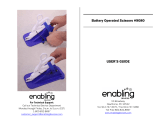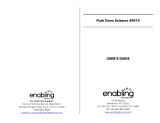
SJIII Compacts & Conventionals
December 2007 Page 5
Table of Contents
Section 2 - Operation (Continued)
2.6 Component Identification (Special Options) ...................................................................................................22
2.6-1 Powered Extension Control Console (If Equipped) ........................................................................22
2.6-2 1500W AC Inverter (If Equipped) ......................................................................................................22
2.6-3 Motion Alarm (If Equipped) ...............................................................................................................22
2.7 Operator’ Responsibility ..................................................................................................................................23
2.8 Visual and Daily Maintenance Inspections .....................................................................................................24
2.9 Function Tests..................................................................................................................................................31
2.10 Start Operation ................................................................................................................................................38
2.10-1 To Activate Base Control Console ....................................................................................................38
2.10-2 To Raise or Lower Platform Using Base Control Console ................................................................38
2.10-3 To Activate Platform Control Console ...............................................................................................39
2.10-4 To Raise or Lower Platform Using Platform Control Console ..........................................................39
2.10-5 To Drive Forward or Backward .........................................................................................................40
2.10-6 To Steer .............................................................................................................................................40
2.10-7 To Select Level Drive or Inclined Drive Mode ...................................................................................41
2.10-8 To Extend/Retract Manual Extension Platform .................................................................................41
2.10-9 To Extend/Retract Powered Extension Platform (If Equipped) .........................................................42
2.10-10 Electrical Inverter (If Equipped) ........................................................................................................42
2.10-11 Shutdown Procedure ........................................................................................................................42
2.11 Guardrail Folding Procedure ...........................................................................................................................43
2.12 Loading/Unloading ..........................................................................................................................................44
2.12-1 Lifting .................................................................................................................................................44
2.12-2 Driving ...............................................................................................................................................45
2.13 Moving the Aerial Platform Through a Doorway .............................................................................................46
2.14 Winching and Towing Procedures ..................................................................................................................48
2.14-1 To Release Free-wheeling Valve .......................................................................................................48
2.14-2 To Release Brakes Manually .............................................................................................................49
2.15 Emergency Lowering Procedure ....................................................................................................................50
2.16 Maintenance Support Procedure ....................................................................................................................51
2.17 Battery Maintenance .......................................................................................................................................52
2.17-1 Battery Service Procedures ..............................................................................................................52
2.17-2 Battery Charging Operation ..............................................................................................................52
2.18 Tables...............................................................................................................................................................56
2.19 Labels ..............................................................................................................................................................66
List of Tables
Table 2.1 Standard and Optional Features .............................................................................................................56
Table 2.2 Owner’s Annual Inspection Record .........................................................................................................57
Table 2.3 Specifications and Features.....................................................................................................................58
Table 2.4 Floor Loading Pressure ............................................................................................................................60
Table 2.5 Maximum Platform Capacities (Evenly Distributed) ................................................................................62
Table 2.6 EC Declaration of Conformity .................................................................................................................63
Table 2.7 Maintenance and Inspection Schedule ...................................................................................................64
Table 2.8 Operator’s Checklist ................................................................................................................................65

























